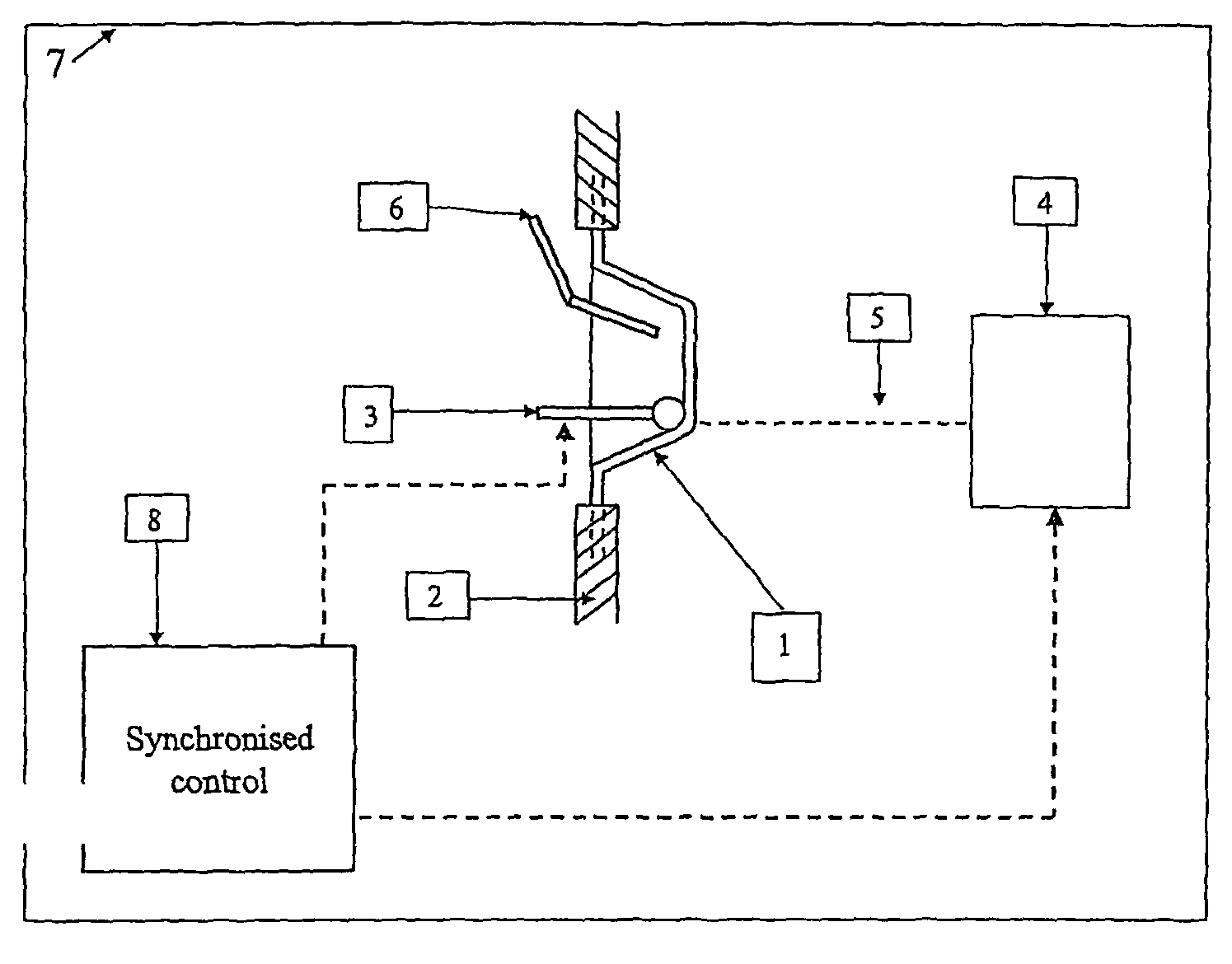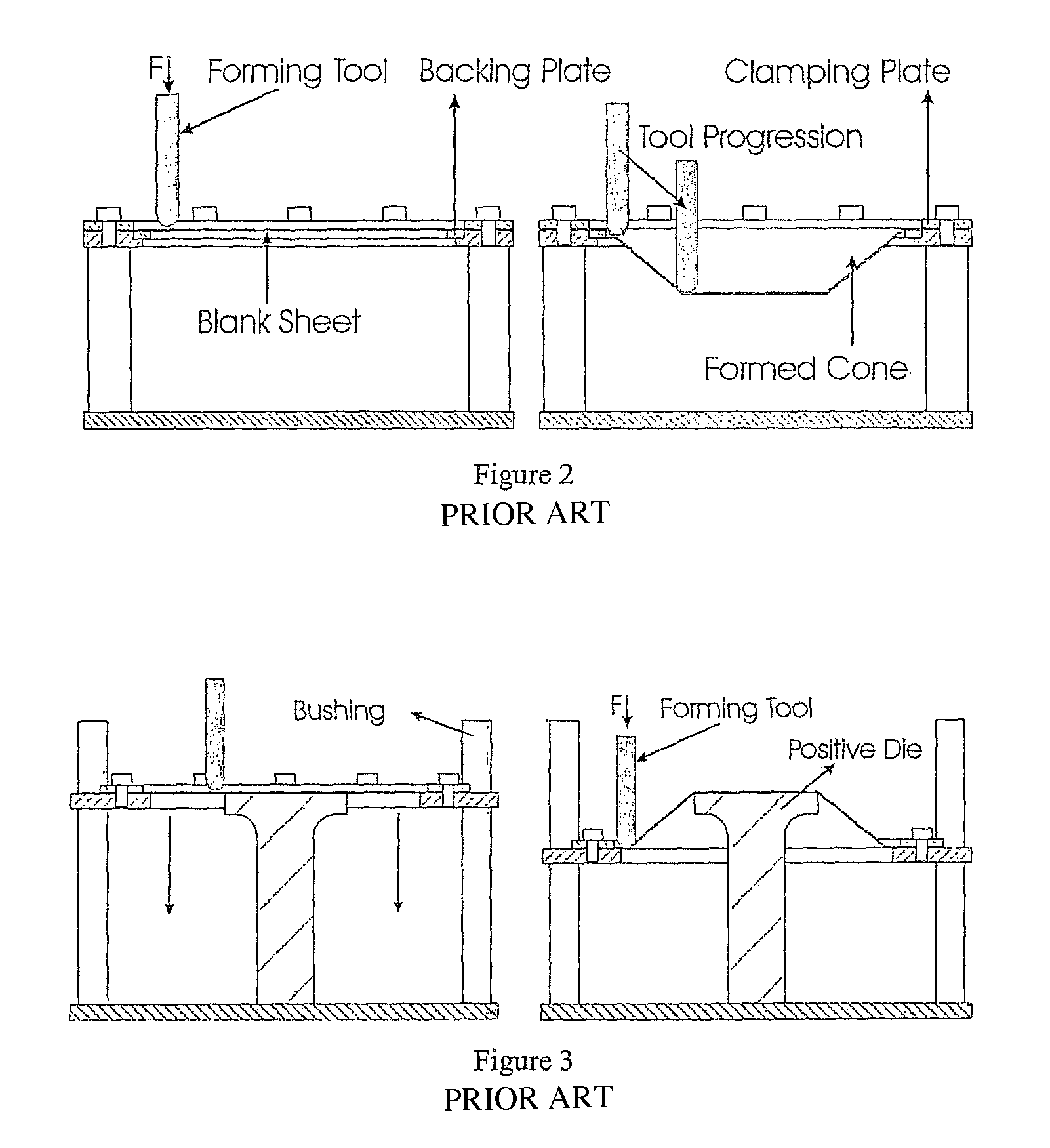Asymmetric incremental sheet forming system
a technology of incremental sheet forming and asymmetric sheet forming, which is applied in the direction of manufacturing tools, metal-working apparatus, shaping tools, etc., can solve the problems of high force on the forming means, low ductility, and more difficult to shape alloy sheets, so as to improve the formability of materials and limit the effect of strainability
- Summary
- Abstract
- Description
- Claims
- Application Information
AI Technical Summary
Benefits of technology
Problems solved by technology
Method used
Image
Examples
example 1
[0047]A sheet metal blank 1 of aluminium alloy EN 5182 (‘Innerlite’) of 1.15 mm thickness and a single point incremental forming means 3 of 10 mm diameter made out of tungsten carbide (‘grade Cki10’) and coated with a high temperature resistant coating, mounted on a 6-axis robot is used to form a pyramid with a wall angle of 40° using a step down of 0.5 mm. First, no heating was applied. and a feed rate of 1500 mm / min was used. In a second test, a Nd:YAG 500 W laser torch, mounted on a 3-axis XYZ-table, was used as the heat source 4 to provide the heat flux to the sheet material at the opposite side of the forming side. The effective laser power was 300 W, a spot size of 7 mm and a feed rate of both the laser and the forming tool of 1125 mm / min were used. The forward offset between the center of the heating and the center of the forming tool was 2.4 mm, while the lateral offset was zero. FIG. 4 gives a top view of the forming surface. The movement of the 9 axes was controlled using ...
example 2
[0048]A sheet metal blank 1 of Din65Cr2 (‘Blue sheet’) of 0.5 mm thickness with Rockwell hardness of about 60 at room temperature and with ultimate tensile strength in function of temperature as shown in FIG. 6 has been used to compare a cold with a heated single point incremental forming test. For the forming a forming means 3 made of tungsten carbide (‘grade Cki10’), coated with a high temperature resistant coating having a diameter of 10 mm and mounted on a 6-axes robot, CNC controlled, has been used to coldly form a conical shape with outer contour 160 mm, depth 40 mm and wall angle 57°. The step down size was 0.5 mm. For lubrication a graphite coating has been applied. The feedrate of the robot was set to 1500 mm / min. It was possible to make this part, whereas the part with wall angle 58° and the same settings as before cracked and thus failed. Therefore, with the settings, material and equipment as mentioned before, the conclusion is that for the cold forming the maximum obtai...
example 3
[0050]A sheet metal blank 1 of Din65Cr2 (‘Blue sheet’) of 0.5 mm thickness with Rockwell hardness of about 60 at room temperature and with ultimate tensile strength in function of temperature as shown in FIG. 6 was used to compare a cold with a heated single point incremental forming test. For the forming a forming means 3 made of tungsten carbide (‘grade Cki10’), coated with a high temperature resistant coating having a diameter of 10 mm and mounted on a 6-axes robot, CNC controlled, was used to coldly form a conical shape with outer contour 160 mm, depth 40 mm and wall angle 50°.
[0051]The step down size 0.5 mm. For lubrication a water-mixable high-performance cutting fluid based on a natural ester (vegetable ester based), known as Vasco 1000 was used. The feedrate of the robot was set to 1500 mm / min. The Din65Cr2 sample was clamped using a square backing plate that was at least 20 mm away from the slope change (i.e. the beginning of the cone). After forming, the sample stayed clam...
PUM
| Property | Measurement | Unit |
|---|---|---|
| diameter | aaaaa | aaaaa |
| diameter | aaaaa | aaaaa |
| diameter | aaaaa | aaaaa |
Abstract
Description
Claims
Application Information
 Login to View More
Login to View More - R&D
- Intellectual Property
- Life Sciences
- Materials
- Tech Scout
- Unparalleled Data Quality
- Higher Quality Content
- 60% Fewer Hallucinations
Browse by: Latest US Patents, China's latest patents, Technical Efficacy Thesaurus, Application Domain, Technology Topic, Popular Technical Reports.
© 2025 PatSnap. All rights reserved.Legal|Privacy policy|Modern Slavery Act Transparency Statement|Sitemap|About US| Contact US: help@patsnap.com



